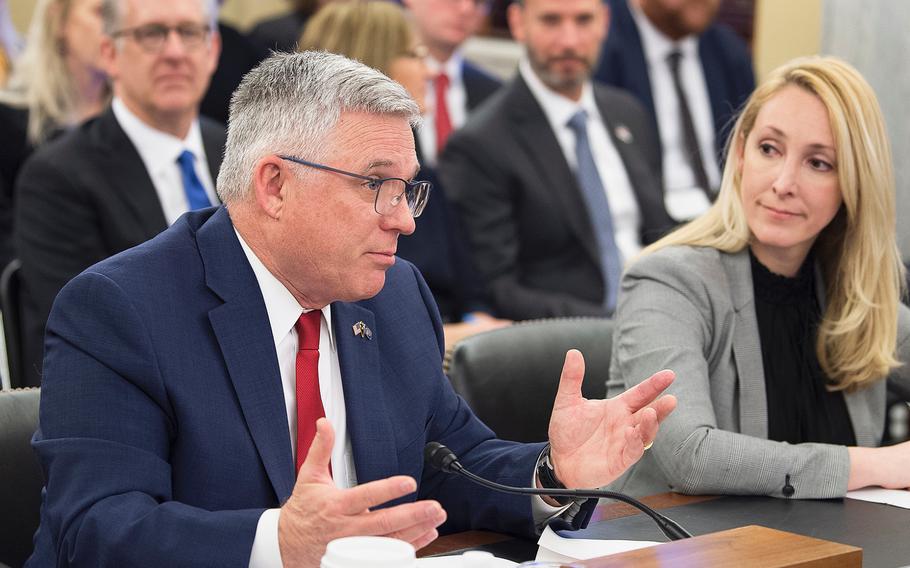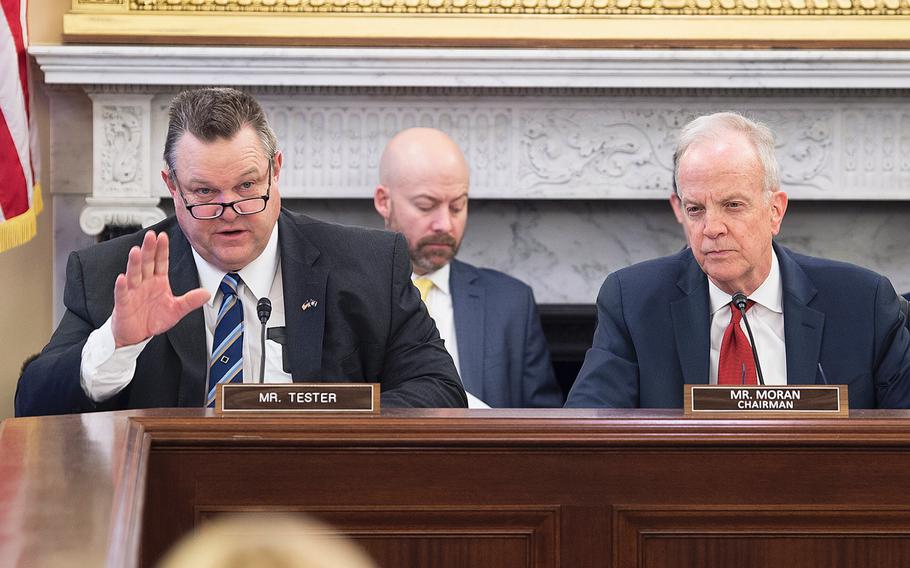
Richard Stone, executive in charge of the Veterans Health Administration, answers questions on Wednesday, Feb. 5, 2020, during a Senate Veterans' Affairs Committee hearing on Capitol Hill in Washington. Looking on at right is Jennifer MacDonald, who was also testifying on behalf of the Veterans Health Administration. (Carlos Bongioanni/Stars and Stripes)
WASHINGTON — Eight months after the Department of Veterans Affairs launched a new program to connect veterans with private-sector doctors, the agency doesn’t know how many appointments have been completed or how much it’s costing taxpayers.
The VA Mission Act, a bipartisan measure intended to expand veterans’ access to private doctors, was the subject of a congressional hearing Wednesday. Members of the Senate Veterans Affairs Committee quizzed VA officials for nearly two hours about the program’s cost, use and ongoing implementation.
Sen. Jon Tester, D-Mont., said he was frustrated that the VA could not forecast the cost. Congress needs to know its funding requirements, he said, especially since President Donald Trump’s budget proposal for the agency in fiscal 2021 is expected to be unveiled next week.
“Eight months into the new community care program, the VA has not provided — or cannot provide — the number of referrals that have become appointments,” Tester said. “And thus, I don’t see how we can figure out how many dollars are associated with those appointments and whether the usage is in line with what you estimated when this program was set up.”
Congress provided about $15 billion for community care in the VA’s latest budget. When Tester asked whether that would be enough, Richard Stone, executive in charge of the Veterans Health Administration, replied: “I think you asked the key question that keeps me up at night.”
Stone said the VA is waiting to tally reimbursement claims from private-sector providers in order to determine how many appointments were completed and at what cost. He provided the committee with a rough estimate: about $1 billion to $1.1 billion each month spent on outside care. At that rate, the program should fall within its funding levels, he said. Stone promised Tester he would return every quarter with an update.

Senate Veterans Affairs Committee Ranking Member Sen. Jon Tester, D-Mont., asks questions to witnesses during a hearing on Capitol Hill in Washington on Wednesday, Feb. 5, 2020. Looking on at right is committee Chairman Jerry Moran, R-Kansas. (Carlos Bongioanni/Stars and Stripes)
“I’m as frustrated as you are,” Stone said. “But at this point our budget looks solid.”
Under the old Veterans Choice Program, which was replaced by the Mission Act, the VA repeatedly ran out of funding in its budget for community care. Then-VA Secretary David Shulkin went to Congress on three separate instances in 2017 asking for more money to keep it viable.
Stone said that shouldn’t be the case this time.
“I’m confident at this point that we are sufficiently funded, that we won’t be up here asking for additional dollars,” he said.
Senators brought up other concerns Wednesday about the implementation of the Mission Act, including whether it would decrease the amount of time veterans wait for care, as intended.
“This committee has concerns about how the VA is building out the network and its ability to meet veteran demand,” said Sen. Jerry Moran, R-Kan., the committee chairman.
Moran brought up a recent report from the VA Inspector General’s Office, which predicted long wait times could worsen under the Mission Act. The IG’s office based its conclusions on the region of VA hospitals that includes 1.6 million veterans across Florida, south Georgia, Puerto Rico and the Caribbean. VA officials in that region referred more than 206,500 requests in 2018 for community care at clinics outside the VA network, with veterans facing a 56-day wait on average before receiving care, according to the report.
During the first month after the Mission Act went into effect, the number of community care consultations in that region increased by more than 1,000, the IG found. The VA has predicted that under the Mission Act, the overall number of veterans eligible to receive community care nationwide will increase from 684,000 to 3.7 million.
“Given the current workload and potential increase in patients eligible to receive community care, it is critical that [the VA] ensures sufficient staffing and efficient processing,” the IG report states.
The VA is creating regional networks of private-sector providers to care for veterans under the new law. The first region, which stretches from the northeastern United States to the mid-Atlantic, recently deployed its network, Moran said. The other three networks in the continental U.S. are expected to be launched by the end of 2020.
“We must take opportunity to learn from region one and have honest conversations about difficulties that could threaten the networks well before it is fully developed,” Moran said. “We owe it to veterans to get Mission right the first time.”
Multiple senators voiced concerns about the VA’s ability to reimburse the private providers who care for veterans under the Mission Act. Sen. Mike Rounds, R-S.D., said two large health care providers in his state are collectively waiting on more than $5 million in reimbursements from the VA.
The agency is working through 2.5 million backlogged claims from private providers, said Kameron Matthews, the VA’s assistant undersecretary for health for community care. The total inventory of claims stands at 3.4 million.
The VA hopes to eliminate the backlog by Sept. 30, the end of the fiscal year, she said.